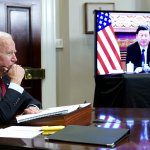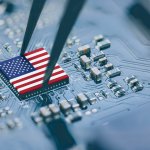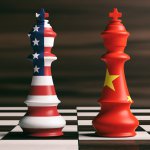US Ratchets Up Anti-Chinese Rules For Chip and Tech Firms – Again

The stalemate between the US and China over semiconductors, AI chips and other high technology industries that will define what the future looks like just got staler still. Hot on the heels of a rule requiring chipmakers to get a new licence certifying that no AI chip they export can be “used in, or diverted to…a military use in China or Russia,” (a move which may cost individual chipmakers and the overall US economy millions of dollars), the Biden administration has attached ten years of anti-China conditions to any funding given to US chipmakers under the recently-signed CHIPS Act.
The CHIPS Act itself is aimed at reinvigorating the US chip sector, to avoid having to rely on Chinese chips, and chips from Asia generally, given the ongoing supply chain slowdown which is driving up the cost of doing business in the tech industry. It’s also aimed at reassuring American workers and businesses that the US is still able to compete in the global market – through massive financial incentives if necessary. The Act commits $280bn to high tech manufacturing and scientific research.
But the geopolitical cold war with China has been ramping up for months as the Biden administration seeks to play hardball on world-changing technology without succumbing to the rabid and careless anti-China stance of its White House predecessor.
That’s why it announced the need for the new license on AI chips just last week, to ensure that chips created at home don’t find their way into the war machines of Russia or China, which would be at the very least counterproductive.
Applying the Guardrails
The new announcement has been described by the administration as “applying the guardrails,” so that any company that receives CHIP Act funding cannot “compromise national security… they’re not allowed to use this money to invest in China, they can’t develop leading-edge technologies in China…. for a period of ten years,” according to US Commerce Secretary, Gina Raimondo. “Companies who receive the money can only expand their mature node factories in China to serve the Chinese market,” she clarified.
“These funds are intended to help companies maximize the scale of their projects. We’re going to be pushing companies to go bigger and be bolder,” Raimondo said. “We’re going to negotiate these deals one at a time,” she added, saying the companies receiving government funds would need to “prove to us the money is absolutely necessary to make these investments.”
At the very least, the newly-announced “guardrails” against investment in China will hamper the plans of some of the most likely recipients of CHIPS funding, just as the new licence proviso is likely to harm the productivity of some of the US’ most prodigious chipmakers but apart from that, the ten-year proviso signals that the US is readying itself for this ongoing technological and commercial cold war to go on for the long term.
Falling Behind on Chip Production
That said, there is a level on which this new restriction should have been expected – the CHIPS Act is designed to promote domestic US chipmaking specifically because of the understanding that – as the US currently produces only around 10% of the global supply of semiconductors, down from nearly 40% in 1990 – America is losing significant ground to China in a fundamental technology that will help define the industry, and the world, of tomorrow.
What’s gained from separating out the announcement from the likes of the CHIPS Act signing is another news cycle of the Biden administration acting tough in the face of growing Chinese supremacy in the sector. That will potentially play well domestically in the run-up to the November midterms, showing an administration prepared to put not just taxpayers’ money where its mouth is, but also to legislate and regulate American protectionism into force in a domestic technology sector that needs to shape up, rather than ship out.
What’s lost by adding these strings to CHIPS funding is possibly the incentive for some leading chipmakers to take the money in the first place, given an increasing bottleneck on the supply chain of the materials needed to make chips domestically. And also, in a geopolitical sense, the stringing out of one big protectionist policy into a series of smaller news hits loses the US the chance to walk back and reach out to China in the event of the CHIPS Act failing to reinvigorate the domestic chipmaking industry as planned.
The Chinese Response
In response to the announcement, the Chinese Embassy in Washington told VOA News “The U.S. politicizes, instrumentalizes and weaponizes tech and trade issues, and engages in tech blockade and decoupling in an attempt to monopolize the world’s advanced technologies, perpetuate its hegemony in the sci-tech sector, and damage the closely-knit global industrial and supply chains. Such moves would hurt others without benefiting oneself.”
Any overtly protectionist strategy risks making a nation look hypocritical when it calls itself the home of capitalism and freedom. The CHIPS Act in itself though looked less like a protectionist move and more like a pro-domestic chipmaking recovery package.
Adding more and more restrictions on how the CHIPS funding can be used – while those restrictions make funding sense – feels like a deal getting mired in too many rules, and risks souring relations between two superpowers for at least the decade stipulated by the new announcement.











